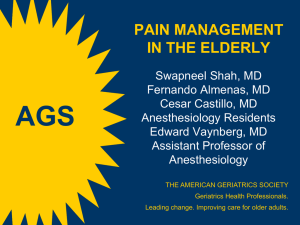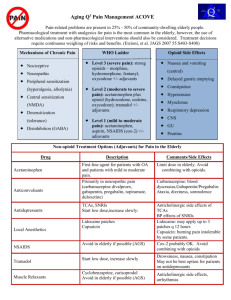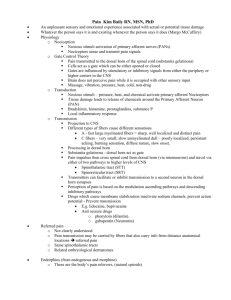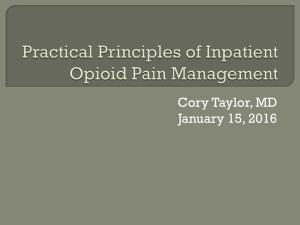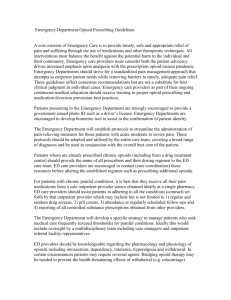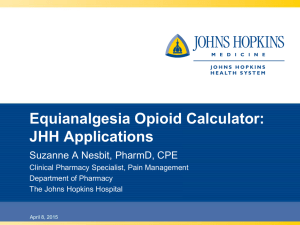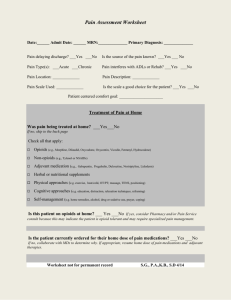Pain Management in the Elderly
advertisement
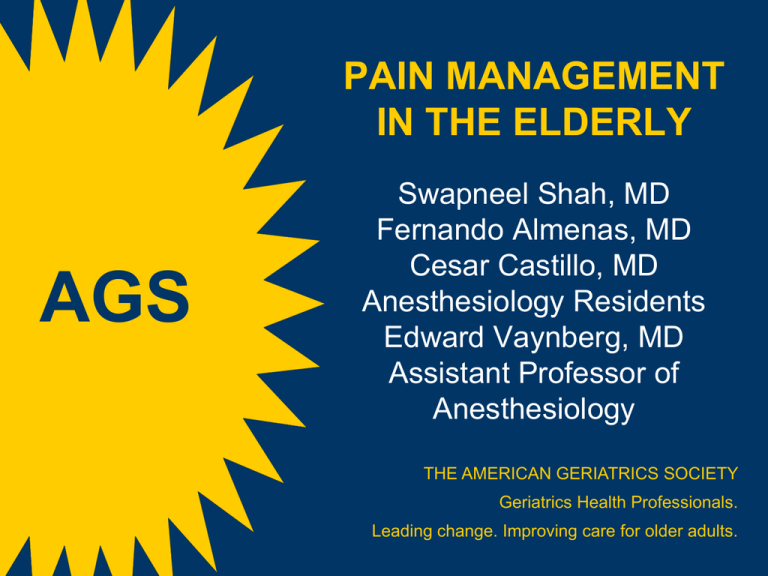
PAIN MANAGEMENT IN THE ELDERLY AGS Swapneel Shah, MD Fernando Almenas, MD Cesar Castillo, MD Anesthesiology Residents Edward Vaynberg, MD Assistant Professor of Anesthesiology THE AMERICAN GERIATRICS SOCIETY Geriatrics Health Professionals. Leading change. Improving care for older adults. 2 OBJECTIVES • Discuss sources of pain in the elderly patient • Review methods for evaluating pain in the elderly patient • Describe therapeutic regimes for the older adult Slide 2 WHY IS THIS IMPORTANT? • Pain is common in the elderly • Pain is under-recognized and undertreated • JCAHO, ACGME/RRC requirements • Lack of formal education on pain control Slide 3 WHY IS PAIN CONTROL OFTEN NOT OPTIMAL? • Clinician unfamiliarity with assessment and treatment • Misconceptions about opioids by patients, families, and clinicians Fear of side effects Concerns about addiction, regulatory reprimands, and lawsuits Slide 4 SOURCES OF PAIN IN THE ELDERLY • Degenerative joint disease • Spinal stenosis • Fractures • Pressure ulcers • Neuropathic pain • Urinary retention • Post-stroke syndrome • Improper positioning • Fibromyalgia • Cancer pain • Contractures • Postherpetic neuralgia • Oral/dental sources • Constipation Slide 5 CONSEQUENCES OF UNRELIEVED PAIN • Sleep disturbance • Functional decline • Depression, anxiety • Polypharmacy • Malnutrition • Prolonged hospital stay • Challenging behaviors • Increased healthcare utilization • Lawsuits Slide 6 AGE DIFFERENCES IN PAIN: CHANGES IN PERCEPTION • Decrease in pain receptors at the skin are a possible mechanism, but no uniform consensus among studies • Regardless of number, function in pain receptors is decreased (both C and A) • Conduction velocities are impaired in both myelinated and unmyelinated fibers at the CNS • Loss of neurons at dorsal horns has been documented Slide 7 AGE DIFFERENCES IN PAIN: CHANGES IN BRAIN PERCEPTION • Decrease in EEG amplitude and increase in latency to painful stimuli have been reported • Painful thermal stimuli activates midline and central cortical regions in young and old, but older adults show activation of frontal and lateral sites This implies wider recruitment of neurons and slower cognitive processing • The elderly have been shown to be more reluctant than young people to report painful stimuli Slide 8 AGE DIFFERENCES IN PAIN: OTHER CHANGES • Normal aging may be associated with impairment in descending endogenous pain inhibition networks • This suggests that adaptation to painful stimuli is reduced in the elderly with age-related dysfunction of both opioid and hormonal systems Slide 9 AGE DIFFERENCES IN PAIN: PRESENTATION • What may be painful to a young adult may present in the elderly as behavioral changes such as confusion, restlessness, aggression, anorexia, and fatigue • When pain is reported, it may be referred from the site of origin in an atypical manner Example: Atypical or asymptomatic MI is rare in younger pts; in elderly survivors, 30% do not report acute symptoms, and 30% have atypical presentations • Elderly women are more likely than elderly men to present with atypical pain Slide 10 PAIN IN THE SETTING OF COGNITIVE IMPAIRMENT (1 of 2) • The intensity of painful conditions and the administration of analgesic medication seem to be inversely related as dementia progresses • Patients may have difficulty expressing the experience or inability to associate the actual experience due to neuropathological changes • In response to pain, cognitively impaired people might show more facial expressiveness This might be related to generalized emotional and behavioral disinhibition rather to pain per se Slide 11 PAIN IN THE SETTING OF COGNITIVE IMPAIRMENT (2 of 2) • As dementia worsens, self-report becomes impossible and it is necessary to rely on pain behaviors and facial expressions • Abrupt changes in behavior and function might be the best indicators of pain Family members and frequent caregivers can aid in obtaining this information Slide 12 ONE-DIMENSIONAL PAIN SCALES Republished with permission from Agency for Health Care Policy and Research (now Agency for Healthcare Research and Quality). Acute Pain Management Guideline Panel. Acute Pain Management in Adults: Operative Procedures. Quick Reference Guide for Clinicians. Rockville, MD: US Department of Health and Human Services, Public Health Service, Agency for Health Care Policy and Research (now Agency for Healthcare Research and Quality). February 1992. AHCPR Pub. No. 92-0019. Slide 13 FACES PAIN SCALE Hicks CL, von Baeyer CL, Spafford P, et al. The Faces Pain Scale-Revised: Toward a common metric in pediatric pain measurement. Pain. 2001;93:173-183. Slide 14 IOWA PAIN THERMOMETER Copyright 2012 by Dr. Keela Herr, College of Nursing, University of Iowa. Reprinted with permission. Slide 15 NONVERBAL PAIN INDICATORS (1 of 2) • Facial expressions: grimacing Less obvious: slight frown, rapid blinking, sad/frightened, any distortion • Vocalizations: crying, moaning, groaning Less obvious: grunting, chanting, calling out, noisy breathing, asking for help • Body movements: guarding Less obvious: rigid, tense posture, fidgeting, pacing, rocking, limping, resistance to moving Slide 16 NONVERBAL PAIN INDICATORS (2 of 2) • Changes in interpersonal interactions Combative, disruptive, resisting care, decreased social interactions, withdrawn • Changes in mental status Confusion, irritability, agitation, crying • Changes in usual activity Refusing food/appetite change, increased wandering, change in sleep habits Slide 17 ASSESSING PAIN: NONVERBAL, MODERATE TO SEVERE IMPAIRMENT (AGS PANEL 2002) • Presence of nonverbal pain behaviors? Assess at rest and with movement • Timely, thorough physical exam • Ensure basic comfort needs are being met (eg, hunger, toileting, loneliness, fear) • Rule out other causative pathologies (eg, urinary retention, constipation, infection) • Consider empiric analgesic trial Slide 18 MULTIMODAL APPROACH TO PAIN MANAGEMENT Pharmacotherapy Physical Therapy Treatment Approaches Interventional Complementary Approaches and Alternative Medicine Exercise Psychological Support Slide 19 MEDICATION SELECTION • Good pain history • Target to the type of pain Neuropathic, nociceptive • Consider non-pharmacologic or non-systemic therapies alone or as adjuvant therapy • Use the WHO 3-step ladder Slide 20 WHO 3-STEP LADDER World Health Organization. Technical Report Series No. 804, Figure 2. Geneva: World Health Organization; 1990. Slide 21 ADJUVANTS • Topical preparations Lidocaine patch, capsaicin • Acetaminophen • NSAIDs Celecoxib, steroids • Anticonvulsants • Antidepressants • Non-pharmacologic (TENS, PT/OT) Slide 22 STEP 1 (MILD PAIN): NON-OPIOIDS • Acetaminophen • NSAIDs • Cox-2 inhibitors • Non-systemic therapies • Non-medication modalities • Other adjuvants Slide 23 STEP 2 (MODERATE PAIN): MILD OPIOIDS, OPIOID-LIKE • Codeine (eg, Tylenol No. 3 with codeine) • Hydrocodone (eg, Vicodin) • Oxycodone (eg, Percocet) • Tramadol (eg, Ultram) • Adjuvants Slide 24 STEP 3 (SEVERE PAIN): STRONG OPIOIDS • Morphine • Oxycodone • Hydromorphone (Dilaudid) • Fentanyl • Oxymorphone • Methadone • Adjuvants Slide 25 TRANSDERMAL FENTANYL • Duration 2472 hours • 1224 hours to reach full analgesic effect • Not recommended as first-line treatment in opiate-naive patients • Lipophilic • Simple conversion rule: 1 mg PO morphine = 0.5 mcg fentanyl (60 mg morphine roughly = 25-mcg patch) Slide 26 OTHER FENTANYL • Intravenous Equivalent to patch dose (eg, Duragesic 100 mcg / 72 = 100 mcg/hr IV) • Transmucosal Actiq Fentora • Iontophoretic fentanyl patch Ionsys Slide 27 METHADONE (1 of 2) • A complicated drug—should be used only by those with experience! • Mu, kappa, delta agonist • Inhibits reuptake of serotonin and norepinephrine • NMDA antagonist (neuropathic pain) • Significant inter-individual variability • Drug interactions (Coumadin-like) Slide 28 METHADONE (2 of 2) • Initial rapid tissue distribution • Slow elimination phase • Long and variable half-life (1358 hours) • Dose interval is variable (q6h or q8h) • Dose usually adjusted every 47 days • Minimally impacted by renal disease • Inexpensive; less street value than other opioids Slide 29 DRUGS TO AVOID IN THE ELDERLY • Meperidine Demerol • Mixed agonist-antagonists eg, Pentazocine (Talwin) Propoxyphene Darvon, Darvocet Slide 30 OPIOID PHARMACOLOGY • Block the release of neurotransmitters in the dorsal horn of spinal cord • Mu, delta, kappa expressed differently, depending on opioid medication • Conjugated in liver • Excreted via kidney (90%–95%) • Exception: methadone is excreted fecally Slide 31 OPIOID USE IN RENAL FAILURE • Avoid meperidine, codeine, dextropropoxyphene, morphine • Use with caution: oxycodone, hydromorphone • Safest: fentanyl, methadone • Opioid dosing by creatinine clearance: >50 mL/min 1050 mL/min <10 mL/min Normal dose 75% of normal dose 50% of normal dose Slide 32 CLEARANCE CONCERNS • Dehydration, renal failure, severe hepatic failure: dosing interval (extend time) or dosage size • With oliguria or anuria: Stop around-the-clock dosing of opioids Use only PRN Slide 33 OPIOID ADVERSE EFFECTS Common Uncommon • • • • • • • • • • • • Constipation Dry mouth Nausea/vomiting Sedation • Sweats Bad dreams/hallucinations Dysphoria/delirium Myoclonus/seizures Pruritus/urticaria Respiratory depression Urinary retention Hypogonadism SIADH Slide 34 GI SIDE EFFECTS OF OPIOIDS • Constipation Never resolves Prevent with scheduled softeners plus stimulants Avoid bulking agents (eg, Metamucil) • Nausea and vomiting Encourage patients to eat frequent, small meals Treat with: • Pro-motility agents (metoclopramide) • Serotonergic blocking agents (odansetron) • Dopaminergic blocking agents (haloperidol, metoclopramide, prochlorperazine) Slide 35 SEDATION AND DELIRIUM WITH OPIOIDS • Consider trying one of the following: If pain control is adequate, decrease dose by 25% Rotate to a different opioid preparation Use small dose of a psychostimulant (2.55 mg methylphenidate or dextroamphetamine) for excessive somnolence • Use nonsedating antipsychotics for delirium (haloperidol, risperidone) Slide 36 OTHER REFERENCES (1 of 4) • Levy M. Drug therapy: pharmacologic treatment of cancer pain. N Engl J Med. 1996;335(15):1124-1132. • EPEC Project. The Robert Wood Johnson Foundation. 1999. • Storey P, Knight CF. UNIPAC 3: assessment and treatment of pain in the terminally ill. AAHPM 2003. • Gazelle G, Fine PG. Methadone for the treatment of pain. J Palliat Med. 2003;6(4):620-621. • AGS Panel on Persistent Pain in Older Persons. JAGS. 2002;50:S205-S224. • American Pain Society. APS Glossary of Pain Terminology. http://www.ampainsoc.org/links/pain_glossary.htm. • Bruera E, Portenoy R. Cancer Pain Assessment and Management. Cambridge University Press, 2003. • Cherny N, Ripamonti C, Pereira J, et al. Strategies to manage the adverse effects of oral morphine: an evidence-based report. J Clin Oncol. 2001;19:2542-2554. Slide 37 OTHER REFERENCES (2 of 4) • Dean M. Opioids in renal failure and dialysis patients. J Pain Symptom Manage. 2004;28(5):497-504. • Gordon DB, Stevenson KK, Griffie J, et al. Opioid equianalgesic calculations. J Palliat Med. 1999;2(2):209-218. • Herr K, Bjoro K, Decker S. Tools for assessment of pain in nonverbal older adults with dementia: a state-of-the-science review. J Pain Symptom Manage. 2006;31(2):170-192. • Hewitt DJ, Portenoy RK. Adjuvant drugs for neuropathic cancer pain. In: Topics in Palliative Care. New York: Oxford University Press; 1998:31-62. • Kirsh KL, Passik SD. Palliative care of the terminally ill drug addict. Cancer Invest. 2006;24:425-431. • Klaschik E, Nauck F, Ostgathe C. Constipation—modern laxative therapy. Support Care Cancer. 2003;11:679-685. Slide 38 OTHER REFERENCES (3 of 4) • McCleane G. Topical analgesics. Med Clin N Am. 2007;91:125139. • Mercadante S, Bruera E. Opioid switching: a systematic and critical review. Cancer Treat Rev. 2006;32:304-315. • Meuser T, Pietruck C, Radbruch L, et al. Symptoms during cancer pain treatment following WHO guidelines: a longitudinal follow-up study of symptom prevalence, severity, and etiology. Pain. 2001;93:247-257. • Skaer TL. Transdermal opioids for cancer pain. Health Qual Life Outcomes. 2006;4(24):1-9. • Swegle JM, Logemann C. Management of common opioidinduced adverse effects. Am Fam Physician. 2006;74:1347-1354. Slide 39 OTHER REFERENCES (4 of 4) • End of Life/Palliative Education Resource Center. http://www.mywhatever.com/cifwriter/library/eperc/fastfact/ff_inde x.html. • American Medical Association Pain Management Series. Management of cancer pain: other analgesic approaches and end-of-life care. http://www.ama-cmeonline.com/pain_mgmt/module12/index.htm. • Bruera E and Sweeney C. Methadone use in cancer patients with pain: a review. J Palliat Med. 2002;5(1):127-137. Slide 40 ACKNOWLEDGMENTS Supported by a grant from the Geriatric Education for Specialty Residents Program (GSR), which is administered by the American Geriatrics Society and funded by the John A. Hartford Foundation of New York City Slide 41 THANK YOU FOR YOUR TIME! Visit us at: www.americangeriatrics.org Facebook.com/AmericanGeriatricsSociety Twitter.com/AmerGeriatrics linkedin.com/company/american-geriatricssociety Slide 42
